When played, the instrument is placed in front of the musician, who uses her right hand to regulate the pitch and vibrate, while plucking the strings with her left hand.
The 16-string zither has a rectangular sounding box, about 110 centimeters long that tapers about 13 cm toward an end, with a warped sound board made of unvarnished light wood. The sides are made of hard wood decorated with various designs, either lacquered or inlaid with mother-of-pearl. The bottom is made of light wood with sound holes. The broader end of the sound box is pierced with 16 holes and reinforced with a metal band.
 Toward the middle of the sound board there are 16 bridges made of wood or bone tipped with copper that can be moved to vary the tension of the strings, thus creating various notes. At the narrower end of the box are sixteen pegs for tuning. The strings are metal and tuned to the pentatonic scale.  The Dan Tranh sits flat like an autoharp and is plucked using all fingers. Players will usually wear picks made of plastic or tortoise shell on their fingers to facilitate plucking. The sound reverberates through the hollow wooden box below the strings. Sounds can be altered through cupping, pressing or stroking the strings instead of simply plucking.
The Dan Tranh originates from the ancient capital of Hue city, where women once played it for royalty, and the instrument is still considered a symbol of the city. The Dan tranh is normally played unaccompanied, but it can also be used to accompany a singer or as part of an orchestra.
|
Thursday, January 31, 2013
Dan Tranh 16 - string zither
The Dan Tranh is also known as Dan Thap Luc or sixteen-stringed zither. Its shape resembles a bamboo tube that has been sliced vertically in half. The Dan Tranh has mostly been seen performed by female musicians in Vietnamese traditional dress (Ao Dai).
Monday, January 28, 2013
Relaxing at An Lam Villas Vietnam
The road from Cam Rahn airport snakes along the coast, past fleets of blue-hulled fishing boats and the beachfront hotels of Nha Trang.
North lies Da Nang and, ultimately, Hanoi, capital of the Republic of Vietnam, but an hour after leaving the airport, a signpost reading An Lam Villas signals a side road leading off Highway One.
A speedboat lies alongside a nearby jetty. We climb aboard, our suitcases follow and the driver guns the engine and sends the boat skimming across Ninh Van Bay to An Lam Villas, the latest resort to lay claim to a share of the tourist dollars flooding Vietnam.
A speedboat lies alongside a nearby jetty. We climb aboard, our suitcases follow and the driver guns the engine and sends the boat skimming across Ninh Van Bay to An Lam Villas, the latest resort to lay claim to a share of the tourist dollars flooding Vietnam.

Accessible only by sea, An Lam Villas is part of the Epikurean stable of up-market properties made up of 35 individual villas, most of which front a lagoon and in which the accent is on low-key luxury.
The villas are large, the walls of the bedroom and living areas sliding back to give views across the private plunge pool and to the lagoon and the beach and bay beyond.
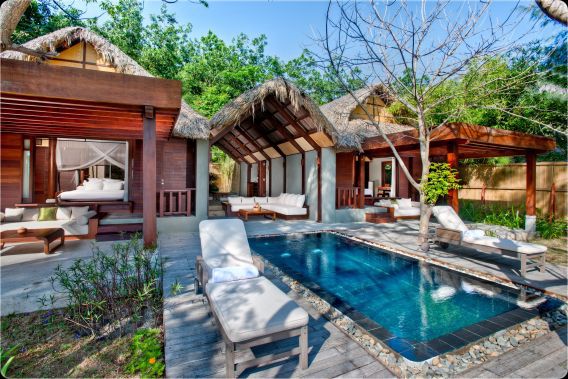
An open-air shower and sunken stone bath tub open off the central area which is fenced by bamboo. At the lagoon edge, day beds stretch beneath a canopy for languid lounging of which you tend to do quite a bit. A stand of pine trees separates the villa and the lagoon, the soft swish of the sea breeze as it moves gently through the branches a potent lullaby. Privacy is absolute and if your concept of a holiday includes hanging off the bar and making several dozen new best friends, then An Lam Villas is not for you.
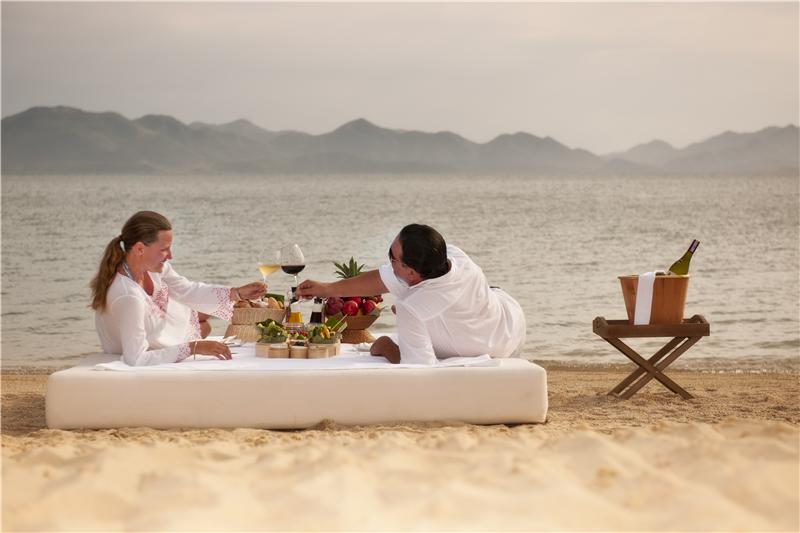
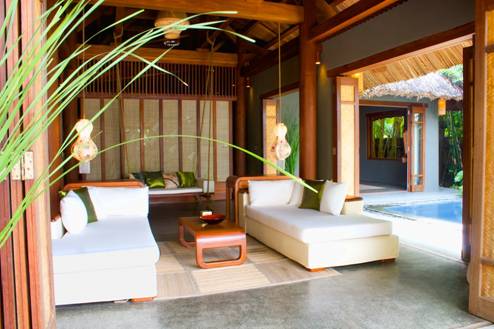
On check-in, guests are asked to indicate the level of attention they require from their personal butler. Do they wish him to attend them at specific times, attend only when called or be constantly at hand. We place Phong, a small, gentle man whose home is in Nha Trang, on standby. He offers to unpack my luggage and I assure him I am capable of doing it myself. Like most Australians, I feel a vague sense of unease when waited upon by a personal servant.
I ask about the bicycles I have seen parked outside villas and Phong produces one within minutes. I pedal along a sandy, shaded road past well-tended herb gardens and the bamboo fencing of my fellow guests, the road rising and then turning down to the beach, the bar, restaurant and infinity swimming pool.
Empty hammocks swing in the afternoon breeze and bodies are draped across deck chairs strung out along the white sand curve of the bay. You can do as little or as much as you like. Recommended activities include fishing, bicycle tours of Nha Trang and surrounds, boating excursions and cooking classes.
I meet the executive chef at dinner that night and the accent is unmistakable. Walk into the kitchen of almost any significant resort or hotel in Asia and you will find an Australian at the burners.
An Lam is no exception and chef Briony Crowder is a Sydney girl who has worked in London, Amsterdam, Istanbul and Thailand and was working in Melbourne when she heard about the position of executive chef with Epikurean.
She's helping train the local chefs and says there are at least two in her team who will become professional, international chefs.
"The challenge is to keep the menus interesting," she says. "We get long-stay guests and we mix the a la carte menu between Western and Vietnamese dishes. My herb garden is coming along wonderfully. Just about anything grows here except some of the European herbs such as thyme." Phong takes us hiking to one of the two waterfalls on the resort from which it sources its fresh water.
We climb for 15 minutes, emerging on a rocky outcrop with sweeping views of the bay. On the rocks, two deck chairs sit beside a pool of spring water. "For picnics," he explains, pointing to the chairs.
There are no jet skis or parasailers at An Lam, just the steady putt-a-putt of the occasional fishing boat as its owner heads out to tend the lobster farms that dot the surrounding waters.
We stayed for three nights and two days, indolently sleeping and reading in the cool retreat of the villa or swimming and lolling on the beach.
In the mornings I stood beneath the open-air shower head, sun shining from a crystal blue sky, warm water cascading down with the only sound the gentle splatter of the shower on the stone floor.
General manager TJ Grundl-Hong, "TJ" to all, owns a nightclub in Ho Chi Minh and operates another Epikurean property on the Mekong. He has run properties throughout Europe and Asia and is as charming as he is knowledgeable. He recommends a restaurant when we return to Ho Chi Minh. "It's the best food in Saigon and it's cheap," he says. "I'll make a reservation for you."
After three days we leave the bliss of An Lam Villas and return to Ho Chi Minh which is gradually reverting in popular usage back to its former name of Saigon. As we depart we pass a couple which TJ says has booked a villa for 40 days. As the speed boat curls away from the jetty and heads back to Nha Trang, I try to imagine 40 days cloaked in the tranquillity of Ninh Van Bay.
The mind can only encompass so much relaxation. That night we catch a cab to the Cuc Gach Quan restaurant (10 Dang Tat, Ward Tan Dinh, HCMC District 3. Ph: +84 83 848 0144).
It's in an old colonial house and overflowing with people and my waiter tells me Angelina Jolie and Brad Pitt were there a few weeks before. The food is some of the best I have ever eaten and the bill, with drinks, comes to about $70.
Empty hammocks swing in the afternoon breeze and bodies are draped across deck chairs strung out along the white sand curve of the bay. You can do as little or as much as you like. Recommended activities include fishing, bicycle tours of Nha Trang and surrounds, boating excursions and cooking classes.
I meet the executive chef at dinner that night and the accent is unmistakable. Walk into the kitchen of almost any significant resort or hotel in Asia and you will find an Australian at the burners.
An Lam is no exception and chef Briony Crowder is a Sydney girl who has worked in London, Amsterdam, Istanbul and Thailand and was working in Melbourne when she heard about the position of executive chef with Epikurean.
She's helping train the local chefs and says there are at least two in her team who will become professional, international chefs.
"The challenge is to keep the menus interesting," she says. "We get long-stay guests and we mix the a la carte menu between Western and Vietnamese dishes. My herb garden is coming along wonderfully. Just about anything grows here except some of the European herbs such as thyme." Phong takes us hiking to one of the two waterfalls on the resort from which it sources its fresh water.
We climb for 15 minutes, emerging on a rocky outcrop with sweeping views of the bay. On the rocks, two deck chairs sit beside a pool of spring water. "For picnics," he explains, pointing to the chairs.
There are no jet skis or parasailers at An Lam, just the steady putt-a-putt of the occasional fishing boat as its owner heads out to tend the lobster farms that dot the surrounding waters.
We stayed for three nights and two days, indolently sleeping and reading in the cool retreat of the villa or swimming and lolling on the beach.
In the mornings I stood beneath the open-air shower head, sun shining from a crystal blue sky, warm water cascading down with the only sound the gentle splatter of the shower on the stone floor.
General manager TJ Grundl-Hong, "TJ" to all, owns a nightclub in Ho Chi Minh and operates another Epikurean property on the Mekong. He has run properties throughout Europe and Asia and is as charming as he is knowledgeable. He recommends a restaurant when we return to Ho Chi Minh. "It's the best food in Saigon and it's cheap," he says. "I'll make a reservation for you."
After three days we leave the bliss of An Lam Villas and return to Ho Chi Minh which is gradually reverting in popular usage back to its former name of Saigon. As we depart we pass a couple which TJ says has booked a villa for 40 days. As the speed boat curls away from the jetty and heads back to Nha Trang, I try to imagine 40 days cloaked in the tranquillity of Ninh Van Bay.
The mind can only encompass so much relaxation. That night we catch a cab to the Cuc Gach Quan restaurant (10 Dang Tat, Ward Tan Dinh, HCMC District 3. Ph: +84 83 848 0144).
It's in an old colonial house and overflowing with people and my waiter tells me Angelina Jolie and Brad Pitt were there a few weeks before. The food is some of the best I have ever eaten and the bill, with drinks, comes to about $70.
Thursday, January 24, 2013
Top 10 bays in Vietnam cannot be missed
Top book center of Vietnam record Organization has just nominated 10 most breathtaking bays in Vietnam. Visitors cannot miss the romantic and stunning scenery of beaches.
1. Ha Long Bay (Quang Ninh)
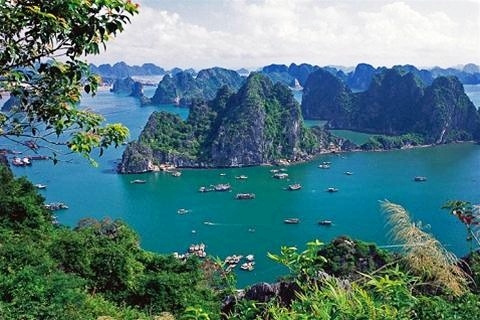
Ha Long Bay is like a vivid huge water-color painting. Thousands of rocky islands bobbing on mysterious shimmering waves, are not only strong and spectacular but also charming and vivid.
On November 11, 2011, The New 7 Wonders Foundation officially listed Ha Long Bay as one of new seven natural wonders of the world.
2. Lang Co Bay (Thua Thien – Hue)

Lang Co Bay, Phu Loc district is a potential place due to the nature and beautiful scenery. Above the bay is Hai Van moutain pass, mountains stretch away to the edge of sea. Below the bay is Lang Co beach with a stretch of white-sand and blue seawater.
Lang Co is a peaceful and primitive beach with a stretch of smooth white- sand and a blue and clear sea. Now, Lang Co Bay is officially the 30th member of World bays Club.
3. Xuan Dai Bay (Phu Yen)
Travelling about 45 kilometers to the north of Tuy Hoa city, Xuan Dai will appear as a water-color painting. The Bay is created by a range of mountains stretching away 15kilometers to the sea. It is like a head of unicorn.

Xuan Dai Bay has a variety of terrain. Rapids follow puddles, puddles follow beaches, beaches follow mountains, stretching endlessly. Xuan Dai has plenty of mountains, islands and peninsulas. All of them bring primitive beauty.
The other distinct character of Xuan Dai is smoothly white sand. In the nominated list of the most beautiful bays in the world, Xuan Dai bay is one of the tourist attractions in Phu Yen.
4. Vung Ro Bay (Phu Yen)
Vung Ro bay comprises 1,640 hectares of water surface with fascinating landscape which is ideal for sightseeing and swimming. There is a lot of seafood and and colorful coral reefs in the seabed of Vung Ro and services of fishing, swimming and diving.

Peninsulas cover Vung Ro, making it a good harbour for ships to anchor, to avoid storms and to fish. Vung Ro is shielded in the north, the west and the east by 3 ranges of mountain Deo Ca, Da Bia and Hon Ba. The south is seaport and Hon Nua island that is 105 meters in height and is like a fortress to guard vessels.
5. Nha Trang Bay (Khanh Hoa)
Shielded by 19 large and small islands, Nha Trang bay is out of wind without big waves. In Nha trang, there are almost 10 islands of salangane. Exploiting salangane’s nest gives Khanh Hoa provincesale of million dollars annually. The other exciting world under the surface of Nha Trang bay is the world of 350 species of coral, 190 species of fish, mollusk, crustacean, sea grass…

Regarding to the ecosystem, Nha Trang bay is one of rare natural system of beaches and bays in the world because it has almost typical and rare ecosystem of tropical beaches. That is wetland ecosystem, coral reefs, mangrove forest, sea grass cover, estuarine ecosystem, island ecosystem, coastal sand ecosystem.
In July 2003, Nha Trang bay, together with Ha Long bay, is officially recognized as one of 29 most beautiful bays in the world.
6. Van Phong bay (Khanh Hoa)
Van Phong is in Van Ninh district. From Nha Trang, it is about 80 kilometres to the north. There is a variety of the terrain of the bay, especially the system of islands, peninsulas, deep bays, attractive sand dunes. The bay has the diverse ecosystems such as tropical forests, mangrove forests, coastal flora and fauna.

In recent years, Van Phong bay has attraction of domestic and international researchers and tourism operators.
7. Ninh Van bay (Khanh Hoa)
Ninh Van is a beautiful island located in the community of Nha Trang bays, in Hon Heo peninsula, Ninh Hoa district, Khanh Hoa. The landscape in Ninh Van unchanges in comparison with the natural and primitive scenery. Ninh Van is like a peaceful heaven with high mountains, and the forest stretching as far as the eye can see.

The smoothly white sand, turquoise blue sea or exciting coral reefs are main factors attracting visitors to go to Ninh Van. You can only see small wooden houses in the seaside, in rocks or in hillside here…
8. Cam Ranh bay (Khanh Hoa)
From Nha Trang city, travelling about 60 kilometers to the south, you will arrive Cam Ranh bay. The bay is immense and tranquil in the color of blue. In the bay, there are many coral reefs and flocks of colorful fish, which attract people having passion on scuba diving.

Beautiful beaches with lines of high coconut trees feature the central coastal region. Cam Ranh bay is an ideal place for international sea tourism such as: boating, fishing, diving and seeing coral reefs, relaxing, treating, climbing mountain…and is in no way inferior to anywhere in the world.
9. Vinh Hy Bay (Ninh Thuan)
Located in Vinh Hy village, Vinh Hai commune, Ninh Hai district, Vinh Hy Bay is about 40 kilometers from the centre of Phan Rang city. Vinh Hy Bay is surrounded by rocky mountains with mysterious caves. Vistors can enjoy clear atmosphere and watch flocks of fish swimming around boats in the blue seawater.

Vinh Hy is a charming picture. In the picture, life of people here and the short stop of visitors are sketchy lines, which make the picture more fascinating. In the journey, tourists will spend time on visiting and feeling the simple and wonderful gift of nature in the central Vietnam.
10. Ha Tien Bay (Kien Giang)
Ha Tien Bay has 105 large and small islands. One of them is Hon Nghe island where fish-breeding is developing, and there are many tourist attractions.

Nature bestows on Ha Tien a harmony of landscapes: mountains, sea, islands and delta combined to form a picturesque land. Ha Tien Bay attracts almost visitors going to Mekong delta due to the breathtaking landscapes and a lot of specialities.
Monday, January 21, 2013
Chu Dong Tu temple altars a immortal Vietnamese spirit
Chu Dong Tu Temple altars Chu Dong Tu - one of four immortal Vietnamese spirits. It still preserves many precious relics, among which is an invaluable pair of Bach Tho vases.
Location: Located in Binh Minh Commune, Khoai Chau District, Hung Yen Province, about 25km from Hanoi along the Red River.
Characteristics: This temple worships Saint Chu Dong Tu, who has been honored as one of four immortal Vietnamese spirits, and his wife, Princess Tien Dung, who was the daughter of 18th King Hung.  Also called Da Hoa Temple, the temple is located on a rectangular, even, wide and high area of 18,720m², facing the west. Its Ngo Mon Gate (Principal Gate) consists of three doors.
The main door leads to a wide and high three-partitioned house with a top engraved with two dragons flanking a moon. This door is only opened on special occasions. The two side doors receive visitors at any time.
 Passing through the yard visitors will arrive Dai Te, Thieu Huong House, De Nhi Palace, De Tam Palace and finally the Sanctuary. The Thieu Huong House was built in a solemn spacious architectural style. The ending of the upper rooftop and the edge of the roof are carved in detail and colourfully modeled with many decorative shapes such as dragons and lions. The door at De Nhi Palace is carved with a phoenix, huge blooming chrysanthemums and other kinds of fruits flowers painted in vermilion and gilt. There are also beautiful bronze statues of Saint Chu Dong Tu and his wife.
Today, Da Hoa Temple still preserves many precious relics, among which is an invaluable pair of Bach Tho vases (Bach Tho here refers to one hundred Tho Chinese characters engraved on the bodies of the vases in various different styles).
If tourists in Vietnam Travel have chance to visit Hung Yen province, Pho Hien is a must-see place that should not be missed!
|
Phu Quoc sim wine big hit with tourists
Ruou sim (wine made from sim fruit or Rose Myrtle) is popular with the many tourists visiting Phu Quoc Island as it delivers a fragrance and sour taste similar to cocktails. However, the man who made the beverage is completely unknown.
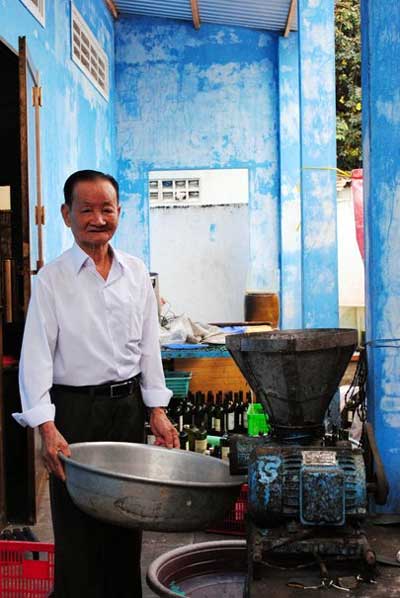
Mac Van Nghiem is seen next to a liquidizer machine.
Mac Van Nghiem was born in the Mekong Delta province of Vinh Long. He lived with his grandfather who helped inspire the young boy to make new varieties of drinks. His first two drinks were made from banana and glutinous rice.
In 1945 his aunt’s husband, a fish sauce seller, took him to Phu Quoc to reunite him with his aunt but the man died of cholera in Ha Tien on the long voyage to the island. So the young Nghiem suffered a tough life without an adult’s protection as he had to work as a firstly a porter at a fish sauce factory and then as a fisherman.
Then, he joined the revolution against the French and lived in the forest where he had gained a reputation for his talent of making wine from acerola fruits, banana and glutinous rice.
After the war, he was head of the financial committee of Phu Quoc Island and retired in 1990. A chance meeting with an officer from HCMC who came to visit the island inspired him to try to make sim wine.
The officer told Nghiem about a recipe on how to make this drink from ethnic minority people in the Central Highlands. After three months of experiments, the first batch of sim wine came out and received great response from Nghiem’s colleagues and friends.
The wine, which is below 15% proof, is suitable for people of all ages.
As the numbers of customers were rising to crazy levels, he decided to start a business out of making sim wine.
He opened a factory and hired workers to speed up the capacity and to answer the high demands of customers.
Nghiem used thousands of sim fruits annually.
However, he was starting to suffer as other rivals imitated his wine and they registered for trade marks to lure customers. Finally, he received support from the chamber of economy and culture to acknowledge him as the creator of sim wine with the registration wine brand named Bay Gao. The wine’s name originates from a love of this wine so its taste delivers customers both the passion and honestly of the true love of one man.
Last year, sim wine of Phu Quoc was voted into the Top 10 most unique wines in Vietnam by the Vietnam Record Books (Vietking).
Nghiem is now 88 but he looks much younger. His youngest son has followed him into the sim wine business to preserve the family’s tradition and his father’s recipe. Apparently the area of sim forest may be narrowed down for construction, however Nghiem said that the local authority has plans to preserve this tree for many years and many factories on the island have planted more trees to maintain the survival of Phu Quoc’s sim wine.
In 1945 his aunt’s husband, a fish sauce seller, took him to Phu Quoc to reunite him with his aunt but the man died of cholera in Ha Tien on the long voyage to the island. So the young Nghiem suffered a tough life without an adult’s protection as he had to work as a firstly a porter at a fish sauce factory and then as a fisherman.
Then, he joined the revolution against the French and lived in the forest where he had gained a reputation for his talent of making wine from acerola fruits, banana and glutinous rice.
After the war, he was head of the financial committee of Phu Quoc Island and retired in 1990. A chance meeting with an officer from HCMC who came to visit the island inspired him to try to make sim wine.
The officer told Nghiem about a recipe on how to make this drink from ethnic minority people in the Central Highlands. After three months of experiments, the first batch of sim wine came out and received great response from Nghiem’s colleagues and friends.
The wine, which is below 15% proof, is suitable for people of all ages.
As the numbers of customers were rising to crazy levels, he decided to start a business out of making sim wine.
He opened a factory and hired workers to speed up the capacity and to answer the high demands of customers.
Nghiem used thousands of sim fruits annually.
However, he was starting to suffer as other rivals imitated his wine and they registered for trade marks to lure customers. Finally, he received support from the chamber of economy and culture to acknowledge him as the creator of sim wine with the registration wine brand named Bay Gao. The wine’s name originates from a love of this wine so its taste delivers customers both the passion and honestly of the true love of one man.
Last year, sim wine of Phu Quoc was voted into the Top 10 most unique wines in Vietnam by the Vietnam Record Books (Vietking).
Nghiem is now 88 but he looks much younger. His youngest son has followed him into the sim wine business to preserve the family’s tradition and his father’s recipe. Apparently the area of sim forest may be narrowed down for construction, however Nghiem said that the local authority has plans to preserve this tree for many years and many factories on the island have planted more trees to maintain the survival of Phu Quoc’s sim wine.
Friday, January 18, 2013
Young artists honor Hanoi
A multidimensional Hanoi is portrayed by 13 artists in a variety of styles and materials in the ongoing exhibition at Art Talk Café, 12 Quan Su, Hanoi.
"Made in Hanoi" is held by Mai Gallery with the idea of an annual exhibition at the beginning of the year to honor Hanoi. Many artists supported the idea and sent their works to the gallery. The first exhibition in 2013 brings together the paintings by 13 artists, who are talented young painters.
In "Made in Hanoi", two paintings of each artist are selected for display (except Pham Tuan Tu with three works.) All of the works are about Hanoi and is specific to the style of each author.
With different materials such as lacquer, oil, synthetic materials and wood engraving, each young artist brings to different views and multi-dimensional images of Hanoi, which express their love to the capital, where they live and work.
The exhibition will open until February 13.
In "Made in Hanoi", two paintings of each artist are selected for display (except Pham Tuan Tu with three works.) All of the works are about Hanoi and is specific to the style of each author.
With different materials such as lacquer, oil, synthetic materials and wood engraving, each young artist brings to different views and multi-dimensional images of Hanoi, which express their love to the capital, where they live and work.
The exhibition will open until February 13.
A number of paintings in the exhibition:

"Red River’s middle plain” by Trieu Long.
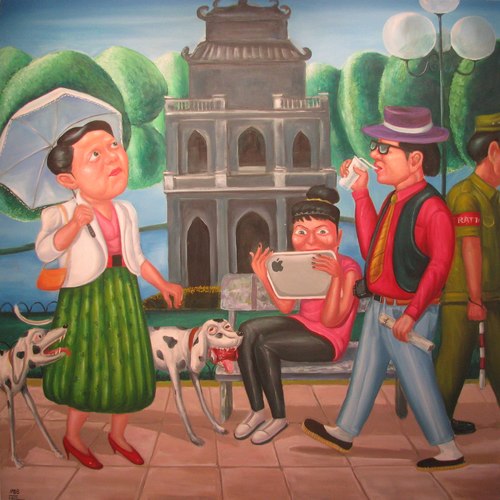
"Sunday" by Nguyen Van Ho.
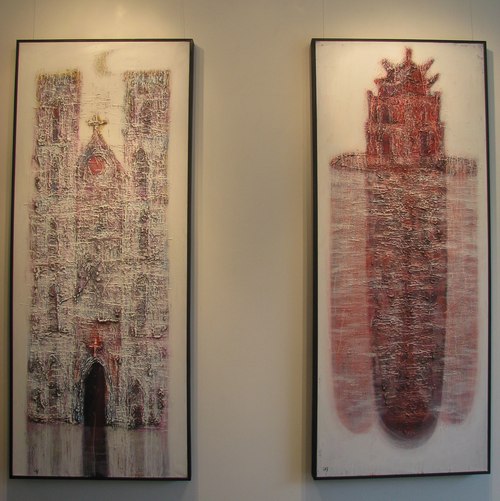 "
"
Church" (left) and "Shadow" by Do Hiep.
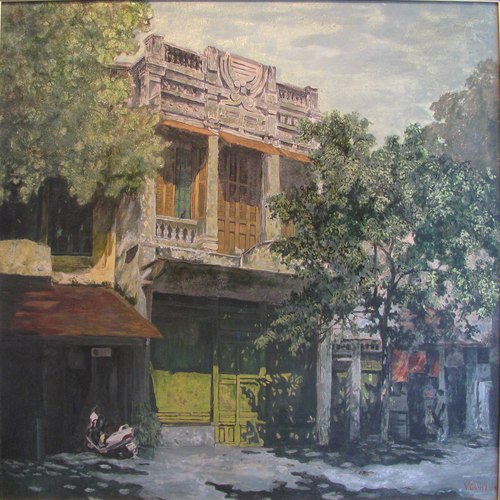
"Ha Noi autumn” by Chu Viet Cuong.

“The Path” by Nguyen Hoang Tung.

“Cherish” by Pham Tuan Tu.
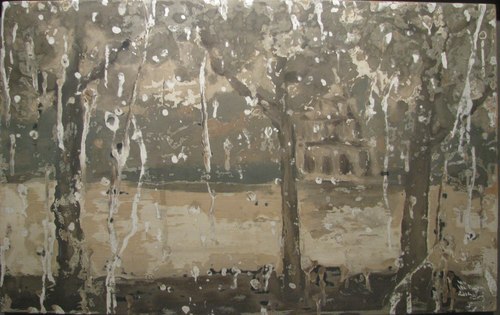
“Rain II” by Vu Duc Trung.
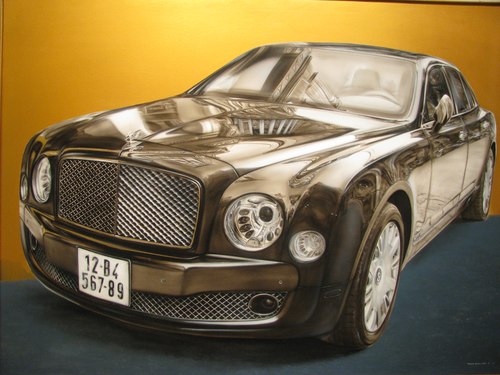
A painting by Trinh Minh Tien.
Tuesday, January 15, 2013
Da Lat - The city of thousand flowers
Dalat city is located in Lam Dong province, on the Lam Vien Plateau, at an altitude of 1500 m above sea level and the natural area: 393.29 km ². Dalat in the highlands Lang Biang, northern province of Lam Dong, on the north, next to the Dalat district of Luoyang, the eastern and southeastern borders with Don Duong district, west and southwest border with 2 Lam Ha and Duc Trong district.









Take a look gentle, graceful as a screen gently pour water from a height of 10 m down a small lake, full of flowers and leaves around the hill through a micro-vu. Prenn Pass is located in the center of Da Lat Prenn about 10 km, located along Highway 20.
To the waterfall, visitors must go through a short bridge across the stream was north embankment with concrete barriers to prevent erosion. The road to a beautiful waterfall with stone steps hug the hillsides are arranged logically; Guests will see a curtain of water let her down from a height of 10 meters near the small valley has been edited into the flower garden from here there are many beautiful way to vacuum up the hills around clear ventilation.
Pongour waterfall: Waterfall also known as a seven-storey waterfalls in Duc Trong district, Lam Dong, Da Lat located 50 km south.
Pongour waterfall

Da Lat is the locality of residence of the Creek, or all of Lang Biang Plateau, an area of over 400 km ², surrounded by mountain ranges and a row: North and Northwest World Choromui limited by range, Yo Da Myut (1816 m), Northwest-based foot mountain Kae Chu Yang (1921 m), in Lang Son Biang the highest peak is Chu Yang Sinh (1408 m). Eastern foot of the mountains Bi Doup (2278 m) plateau slopes down to Dran. Southeast definitely taught by Proline (1629 m). South and southwest are the mountains Elephant (1754 m) and Yang Soreng surrounded. Because the influence of elevation and pine trees surrounded, Dalat's many features of the temperate domain. Average temperature 18-21 ° C, the highest temperature never exceed 30 ° C and lowest is not below 5 ° C.
To Dalat, Vietnam guider will help you not be happy to "pass climbing, wading streams" but also to visit the villas of Bao Dai, or temples and ancient church of the nation. Paris is such a State, Da Lat should ever dream dreams and poetry through the cold highlands night, morning fog and strip pine forests around the cities.
Trúc Lâm Zen Monastery
Truc Lam Zen Monastery is the largest in Vietnam, inaugurated in 1994, is one of the largest Buddhist building after 1975. Wat is located next to Tuyen Lam lake on a large land area 25 ha. Truc Lam is currently connected to the city center of Da Lat (Robin Hill) with the cable system, transporting visitors back to Zen and Tuyen Lam ve.Ho 2005 the government of Lam Dong to build a major tourist area, attracting approximately about 30 investors.
Linh Phuoc Pagoda is also called Wat Chai Ve because the airport is 49 m long dragon made of 12,000 bottle, porcelain. Wat is a unique architectural mosaic connoisseurs of Dalat. Pagoda is located at Camp Mat, a town center 10 km to the east.
Linh Son Pagoda was built from 1938 to 1940 due to the contribution of Buddhists, especially Mr. Vo Dinh and Nguyen Van Tien Dung, who received most of the bidding architecture period.
Thien Vuong Co Sat Pagoda was built starting in 1958, the center of Da Lat is about 5 km, is located on a Hill. The main temple has three power 4 m high Buddha visiting from Hong Kong, behind the temple, on the Hill Thich Ca Buddha statue is 20 meters high Radio Chua also called Chua Tau, the system Hue Nghiem Buddhist sects in China.
Linh Phong Pagoda is located in Hoang Hoa Tham, built in 1944. In temples, there should nun temple also known as unused Women.
Linh Quang Pagoda, the family's first throne of Da Lat, located on Hai Ba Trung Thuong Thich Thursday by creating in 1931.
Church
Church district court Dalat often referred to as Church Chicken because the chickens on the roof, a symbol of St. Peter Coffee. Church started construction in 1931, to 1942 is complete. The church is one of the typical architectural style and ancient Dalat.

Churches Chicken
In addition, Da Lat also has several churches, such as Domaine de Marie Church with a beautiful French architecture, the poet also has a beautiful flower garden with two trees on the 75-year-old Tung, church architecture Student Travel Vietnam with a traditional curved roof and dragon. Cam Ly church was built from 1960 to 1968-style home empty Highlands.
Mansion
Da Lat has many beautiful palaces and villas as
Nutrition I: worked as the national head office of Bao Dai, now the company K'Gim - Korean investment into the hotel, high-class entertainment.
Nutrition II: each villa resort is the full Decoux, and then by Ngo Dinh Diem and Nguyen Cao Ky. After 1975 the guest house of Lam Dong Province People's Committee.
Dinh III: also known as Bao Dai palace, built in 1933, located in the Vietnamese roads Wang Zhao, near Institute of vaccines and biological products Dalat. Since 1949, Da Lat is the capital of the imperial dynasty diamond territory, King Bao Dai lived with family and work here. We still maintained the status quo Left 25 rooms and some kind of his last Nguyen Dynasty kings, queens Nam Phuong, the prince and princess. Flower garden before special power meticulous care.
Villa Long My District of Nguyen Huu Hao (father of Nam Phuong Nguyen Huu Thi Lan - wife of King Bao Dai).
Villa Nam term governor, now the headquarters of Lam Dong Province People's Committee.
Hang Nga Villa.
Landscape

Hill Cu
Cu hills between downtown Dalat is located next to Xuan Huong Lake is so often mentioned as a place bonded together - many people believe that Da Lat will be less if the lack of fine hill and Cu Xuan Huong Lake . In 1942, the design planning schemes of Dalat, architects Lagisquet Hill was zoned as an area Cu impregnable to create a clear vision system for Dalat. Later, a British architect who designed the conversion of Cu 9 hole golf course is quite famous Southeast Asia and the Cu current hill has been upgraded into 18-hole golf course. Hill is not clear Cu name ever since, and why is called "Hill Cu" two-pronged justification is there, some have argued that the gentle backdrop of hills here when viewed from far back as the ceiling panels of the hardworking should have been huge for von-called "Hill Cu"; also move the office to explain the name "Hill Cu" because this is a place where golf also known as the hardworking type.
Xuân Hương Lake

Sunshine on Xuan Huong Lake
Xuan Huong Lake in the heart of Dalat and next hill Cu. Ho is in fact artificial lake was built in 1919 by initiative of Cunhac. To form the lake, people sure beats covering a stream running through valleys, lakes have large surface area of 25 ha, 5.1 km long perimeter. Around the lake many unique architectural value of art, aesthetic built the Palace hotel, sports fields Lam Vien, motels Union, Restaurant Thanh Thuy, Thuy Ta ... Previously called Grand Lac lake (largest lake). Early morning fog on the very beautiful and romantic.
Lakes and streams Gold

Lakes and streams Gold
Suoi Vang Lake is the largest freshwater lake in Da Lat, providing water for the city over the spillway water supply company Dalat. Golden Valley Springs is famous tourist destination with flower gardens and pine forests.
Dalat Flower Park

Parks vibrant flowers in Da Lat
Dalat Flower Park is situated around the north shore of Xuan Huong Lake, the valley of the Hill Cu. Formerly Da Lat Flower Park called Bich, now an area of the park was extended to 7000 flowers m², with a layout not get too stuffy, the impression came to visit. The flowers and ornamental famous Dalat grown trimmed thoughtful care, scene fresh, rich seasons. Usually hold annual flower festival and a message to call and attract investors to the domestic and foreign development of Da Lat and its suburbs into the center of production, export and flower of the country Southeast Asia.
Peak LangBiang

Langbiang
Located at an altitude of 2169 m above sea level, contained in his hidden Langbiang legend of a flame, beyond the feudal ceremony of education. Langbiang also such as "the roof" of the Lam Vien Plateau, rooftops, Da Lat, is to select ideal for visitors to enjoy the feeling bồng disease, which include travelers thirst for conquest, discover the real amazing and fun adventure agreement evidences the ball.
Than Thở Lake

Than Tho Lake
Is a natural lake in the city of Da Lat (Lam Dong province) and also a tourist destination of this city. Journal Indochine (Indochina) 28 out March 13 1941 Than Tho Lake photo chosen as the cover image. Previously Than Tho lake is a pond called Tono Pang line. In 1917, the French built dam reservoirs provide water for the city of Da Lat.
The French named the lake is Lac des Soupirs meaning Monday (whisper), but when translated into Vietnamese Left progress in the sense first: Than Tho Lake.
Cam Ly Waterfall
Cam Ly waterfall
Located near the city center of Da Lat, the Peace just 2.3 km to the east - south. Waterfalls are not nice and often less water in the dry season but thanks to the location near the city center so visitors have visited.
Prenn waterfall
Take a look gentle, graceful as a screen gently pour water from a height of 10 m down a small lake, full of flowers and leaves around the hill through a micro-vu. Prenn Pass is located in the center of Da Lat Prenn about 10 km, located along Highway 20.
To the waterfall, visitors must go through a short bridge across the stream was north embankment with concrete barriers to prevent erosion. The road to a beautiful waterfall with stone steps hug the hillsides are arranged logically; Guests will see a curtain of water let her down from a height of 10 meters near the small valley has been edited into the flower garden from here there are many beautiful way to vacuum up the hills around clear ventilation.
Pongour waterfall: Waterfall also known as a seven-storey waterfalls in Duc Trong district, Lam Dong, Da Lat located 50 km south.
Pongour waterfall
Waterfalls pour from a height of nearly 40 meters, spread over 100 meters wide, stone stairs system seven floors. Surrounding forests is an area of 2.5 hectares with vegetation diversity and abundance.
Valley of Love
As one of the most romantic landscapes in Dalat, the city center is about 6 km to the northeast. That is where Da Thien Dam (built in 1972) gathers the small stream flowing from the high hills, a lake (Lake Da Thien) in the extractor winding valley through green shaded. Initially, the French call this place the Vallée d'Amour (Love Valley) after it was renamed the Valley of Peace, and in 1953 returned to the Valley of Love.
Valley of Love
Valley of Love and Beauty smoking by rolling hills and through deep valley. In 1972, the dams were built across the valley extractor formed of Da Thien, augment the seductive landscape generally, and appear two other names besides beating the Valley of Love 3 Da Thien Lake and 3.
Guests can follow the path men or climb the percentage level, go through the gate with brightly colored flowers up to Vong Canh hill. From there, Valley of Love showing on the beautiful eyes a picture vivid title.
It is an ideal destination for romantic souls and those who love farming highlands as well as temperate climate.
Subscribe to:
Comments (Atom)